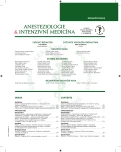Case report of missed diagnosis of intracranial haemorrhage in a patient after tricuspid valve annuloplasty
Authors:
Matloch Zdeněk 1; Říha Hynek 1; Netuka Ivan 2; Kment Martin 3; Kotulák Tomáš 1
Authors‘ workplace:
Klinika anesteziologie a resuscitace, Institut klinické a experimentální medicíny, Praha
1; Klinika kardiovaskulární chirurgie, Institut klinické a experimentální medicíny, Praha
2; Oddělení klinické patologie, Institut klinické a experimentální medicíny, Praha
3
Published in:
Anest. intenziv. Med., 25, 2014, č. 4, s. 277-280
Category:
Anaesthesiology - Case Report
Overview
This case report describes the management of a patient who required reoperation for tricuspid valve regurgitation. The procedure was further complicated by right ventricular failure and an unsatisfactory result of tricuspid valve annuloplasty. On the ICU this patient developed systemic inflammatory response syndrome, followed by multiple-organ failure requiring V-A ECMO. The clinical course was also complicated by acute kidney failure needing continuous renal replacement therapy and by pulmonary haemorrhage requiring several bronchoscopy interventions and blood transfusions. The patient deceased 5 days after surgery. The presumed causes of death were 1) systemic inflammatory syndrome with profound vasoplegia, 2) right ventricular failure and 3) pulmonary haemorrhage. Autopsy revealed assumed shock organ changes but also brain haemorrhage. This unexpected pathology may have contributed to the patient’s hemodynamic instability. In a situation where standard neurological methods are inconclusive, novel biochemical markers of brain damage could be helpful.
Keywords:
anaesthesia – cerebral protection – mechanical circulatory assistance – valve disease
Sources
1. Moresco, L., Bellissima, V., Colivicchi, M., Crivelli, S., Guerriero, F., Ricotti, A., Sabatini, M., Strozzi, M. C., Temporini, F., Gazzolo, D.Markers of brain injury in non-invasive biological fluids. Minerva Pediatr. 2010, 62, p. 141–143.
2. Mateen, F. J., Muralidharan, R., Shinohara, R. T., Parisi, J. E., Schears, G. J., Wijdicks, E. F. Neurological injury in adults treated with extracorporeal membrane oxygenation. Arch. Neurol., 2011, 68, p. 1543–1549.
3. Hervey-Jumper, S. L., Annich, G. M., Yancon, A. R., Garton, H. J.,Muraszko, K. M., Maher, C. O. Neurological complications of extracorporeal membrane oxygenation in children. J. Neurosurg. Pediatr., 2011, 7, p. 338–344.
4. De Mol, A. C., Gerrits, L. C., van Heijst, A. F., Straatman, H., van der Staak, F. H., Liem, K. D. Intravascular volume administration: a contributing risk factor for intracranial hemorrhage during extracorporeal membrane oxygenation? Pediatrics, 2008, 6, p. 1599–1603.
5. Szabó, G. Physiologic changes after brain death. J. Heart. Lung. Transplant., 2004, 23, p. 223–226.
Labels
Anaesthesiology, Resuscitation and Inten Intensive Care MedicineArticle was published in
Anaesthesiology and Intensive Care Medicine

2014 Issue 4
Most read in this issue
- A kidney for sale – I need the money
- Difficult weaning – physiological approach (focusing on cardial causes)
- Sepsis, severe sepsis and septic shock
- Clinical practice guideline on diagnosis and treatment of hyponatraemia
